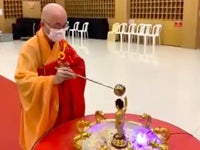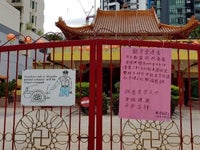Ritual Adaptations on Telok Ayer: Liturgical Negotiations in a Chinese Temple and a Methodist Church
contributed by Lynn Wong, 26 June 2020
In my previous post, I shared my personal experience and methodology in conducting ethnography research without the usual embodied fieldwork as the pandemic evolved.
In this post, I will share some of the findings I had gathered in my capacity as an independent researcher working on Singapore Heritage Society (SHS)’s historic places of worship research project since 2017. As part of SHS’ ongoing efforts to understand the views and needs of stakeholders, I caught up with stakeholders via phone in May 2020 to gather their insights. Below, I draw examples from 2 historic places of worship on Telok Ayer.
Siang Cho Keong (仙祖宫) “Palace of the Celestial Patriarch”
Tua Pek Kong’s birthday celebrations on 24th February 2020 would have been a bustling one at the 153-year-old family-run Chinese temple Siang Cho Keong. Every year, devotees would gather in the temple’s small main hall before Tua Pek Kong to present him with individual paper robes and make personal prayers that may last 10 to 15 minutes. The heat and proximity with fellow devotees in the small prayer hall does not seem to bother them, for they believe that it is before the physical presence of the deity that their worship would be efficacious.
However, the announcement of DORSCON Orange (Disease Outbreak Response System Condition) saw the number of devotees coming halved. With tighter measures (such as the need to maintain at least 1 metre social distance), the ritual for the presentation of paper robes to the deity (献袍仪式) was forced to become a hasty affair. Instead of collecting the individual paper robes for worship, devotees were told that their names have already been written and affixed onto a large “communal” paper robe hung outside the temple. Devotees were also advised to do their prayers outside the main hall. Those who wished to enter the main hall for prayers may still do so, but they had to adhere to the safety distancing measures and were encouraged to keep their prayers short (e.g., 1 - 2 minutes).
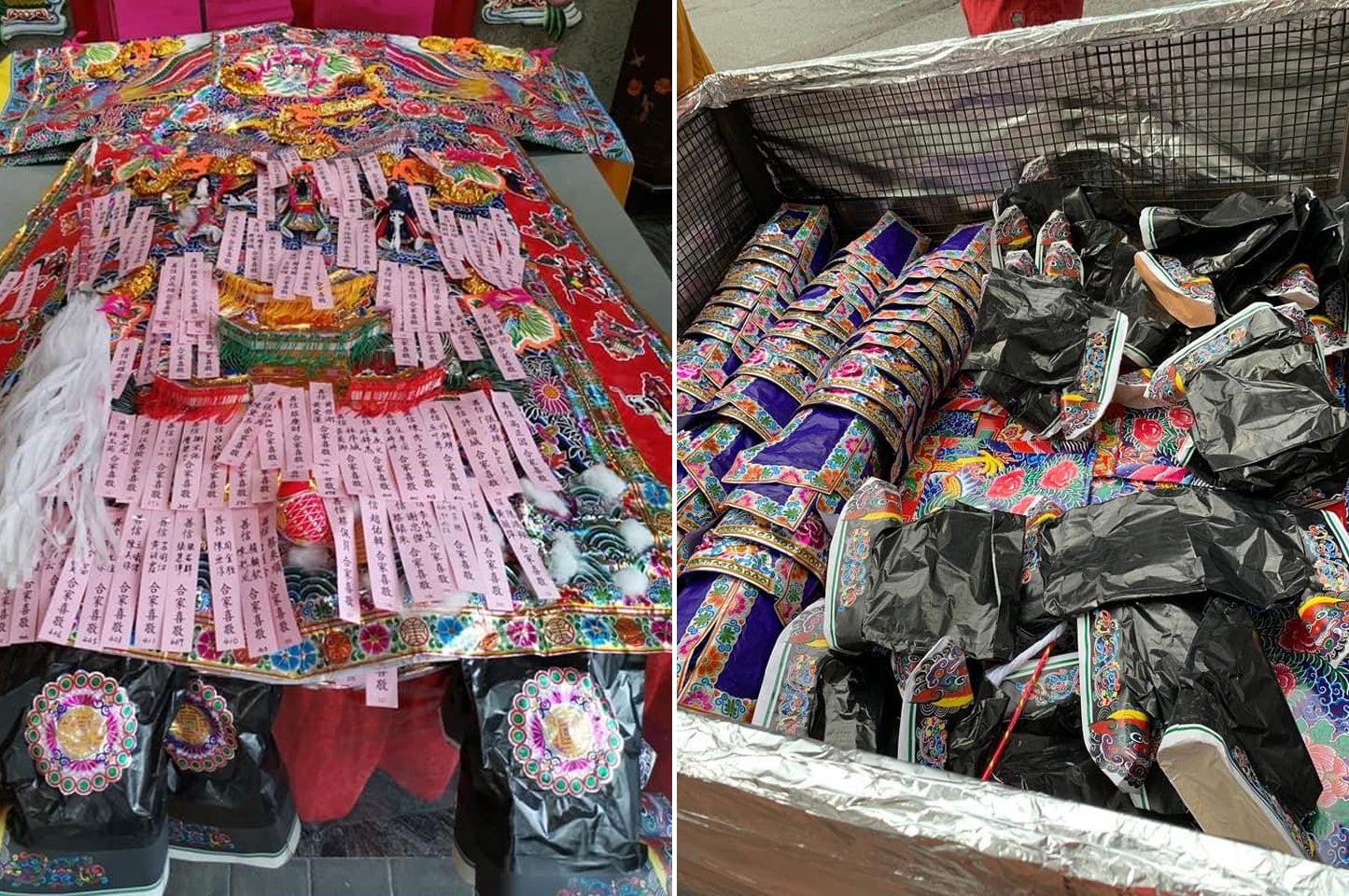
Photo taken on 24 Feb 2020, posted by Siang Cho Keong on its Facebook: Large paper robe with names of all devotees participating in the “presentation of the robes” ritual (left). Burner filled with individual paper robe offerings (right)
Interestingly, this practice of presenting a large “communal” paper robe with the names of devotees has been rolled out at the temple in the past 1 to 2 years after consultation with the temple’s religious advisor. This ritual adaptation was part of the temple’s efforts to reduce pollution from burning individual paper robes. In the early days, it was customary to offer one paper robe per devotee. This year, the number of individual paper robes purchased by devotees remains largely the same as previous years, because of the temple’s usual clientele and also because arrangements had already been made prior to the abrupt announcement of DORSCON Orange. It remains to be seen if this ritual adaptation encouraged by the temple will be maintained among its devotees in subsequent festivals.
Even as Singapore loosens its regulations from 2nd June 2020 onwards, Siang Cho Keong foresees that all other festivals this year will have to be simplified. Celebrations for the temple’s patron deity Lü Dongbin 呂洞賓, which were supposed to be held on 6th May 2020, fell within the Circuit Breaker period and had to be cancelled. As Lü Dongbin--understood as the “Celestial Patriarch”--is the highest ranked in the temple’s pantheon of deities, the other temple events cannot be organised at a grander scale than that accorded for the patron deity. For instance, the usual opera performance for deities on temple festivals may not be staged and food offerings may not be as elaborate. The other temple events in the year include the temple’s anniversary (祈福消灾法会) and the Lantern Ritual for the Seven Stars of the Northern Dipper (北斗七星灯仪).

Photo posted on Siang Cho Keong’s Facebook on 5 April 2020 informing devotees about the temple’s closure from 6 April to 4 May 2020
Telok Ayer Chinese Methodist Church (TACMC)
The year 2020 was planned to be an inactive year for the Methodist Church on Telok Ayer. The church had just held its large-scale 130th anniversary celebrations in 2019 and was preparing major renovation works to create coffee corners and new spaces to welcome the public and allow the Central Business District (CBD) crowd to use its facilities for lunch. Little did they expect “inactivity” to take on a different form as the Covid-19 pandemic evolved.
Several church members expressed health safety concerns after the DORSCON Orange announcement in early February, and a 30% decline in attendance for Sunday worship service was observed. In response, the church swiftly rolled out live-streaming Sunday worship services on its Facebook in parallel to its onsite service starting from 16th February 2020. The church also announced that should any worshipper “feel that they would prefer to stay away from church for a time”, the church will “adopt an understanding approach, and will not judge nor consider it a measure of their faith”. A new Youtube channel of animated Bible stories was also created by the church’s talented pastoral staff on 17th March 2020 to reach out to children.
On 20th March 2020, the church announced a suspension of physical church services for two weeks. It is important to note that this was prior to the government announcement for tighter restrictions on 24th March 2020. This 14-day suspension was executed in the view that this would have allowed for an incubation period to ward off any potential infection and allow the church to “start afresh”, ready for Palm Sunday (5th April 2020) and the series of events leading up to Easter Sunday (12th April 2020). But alas, the Circuit Breaker measures were announced even before Palm Sunday arrived. As such, TACMC had not been able to resume service onsite since 22 March 2020.
Although worship service went fully online, worshippers are encouraged to treat it as if it were a physical worship in church. For instance, worshippers are advised to dress in their Sunday best, switch mobile phones to silent mode, and physically participate as instructed during the service (e.g., rise to sing, close eyes to say prayers, read up during scripture response) even if alone at home. Sunday service streaming videos were also made available only till 6pm to encourage members to participate in worship on Sunday itself.
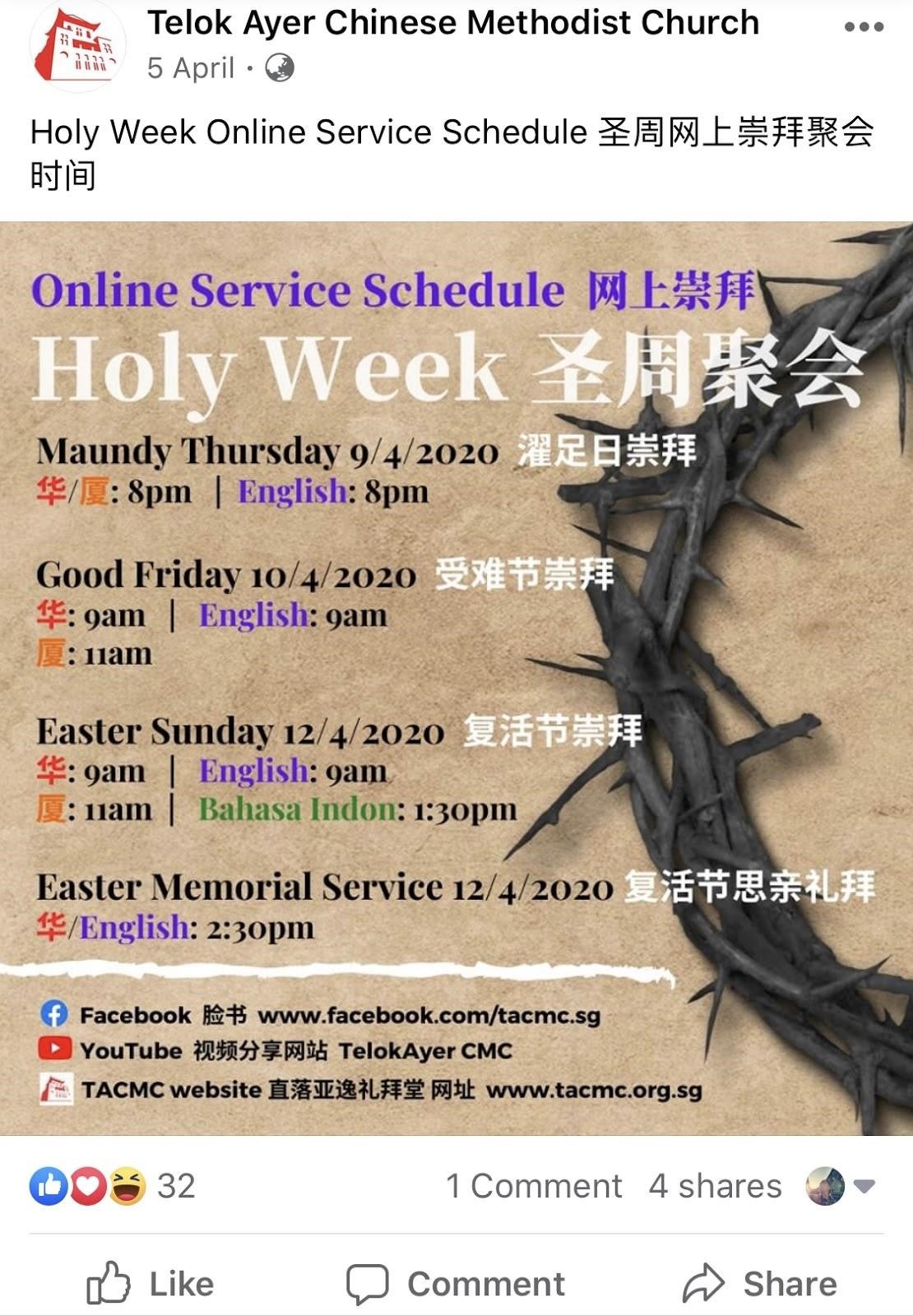
Facebook post by TACMC on 5 April 2020 announcing its online service schedule for the Holy Week
Many rituals, however, had to be simplified, modified, or suspended.
For instance, baptism, which is usually conducted only twice a year (Easter Sunday and Christmas Sunday), was suspended for this year’s Easter Sunday (12th April 2020). The church views that the declaration of one’s faith in public and the sprinkling of physical water to signify cleansing are key rituals in baptism. As such, an “online baptism” would be meaningless. They are however open to the possibility of having a limited number of candidates at any one-time receiving baptism with the physical water and making their declaration in the online presence of other members of the church.
A ritual simplified was the removal of every sacred item on the Holy Communion Table (including the pulpit, articles, bible) on Maundy Thursday (9th April 2020). Particularly missing on the table were the Holy Communion Cups and elements as the Sacrament of Holy Communion segment could not be performed without a physical congregation.
The ritual of making offerings (i.e., donations) is an interesting example of modification. In the Methodist view, making offerings is a key part in the whole event of worship to give thanks to God. Accordingly, the act of bringing physical money and placing it in offering bags carries that significance. Hence, although the option of making offerings online existed prior to Covid-19, it was used by only a small percentage of the church worshippers. With the physical closure of the church, members were encouraged to make online bank transfers for offerings. This however proved challenging for the elderly, especially its Hokkien congregation. As such, the church suggested that members could make offerings by placing money into an envelope and keep it till physical church services resume.
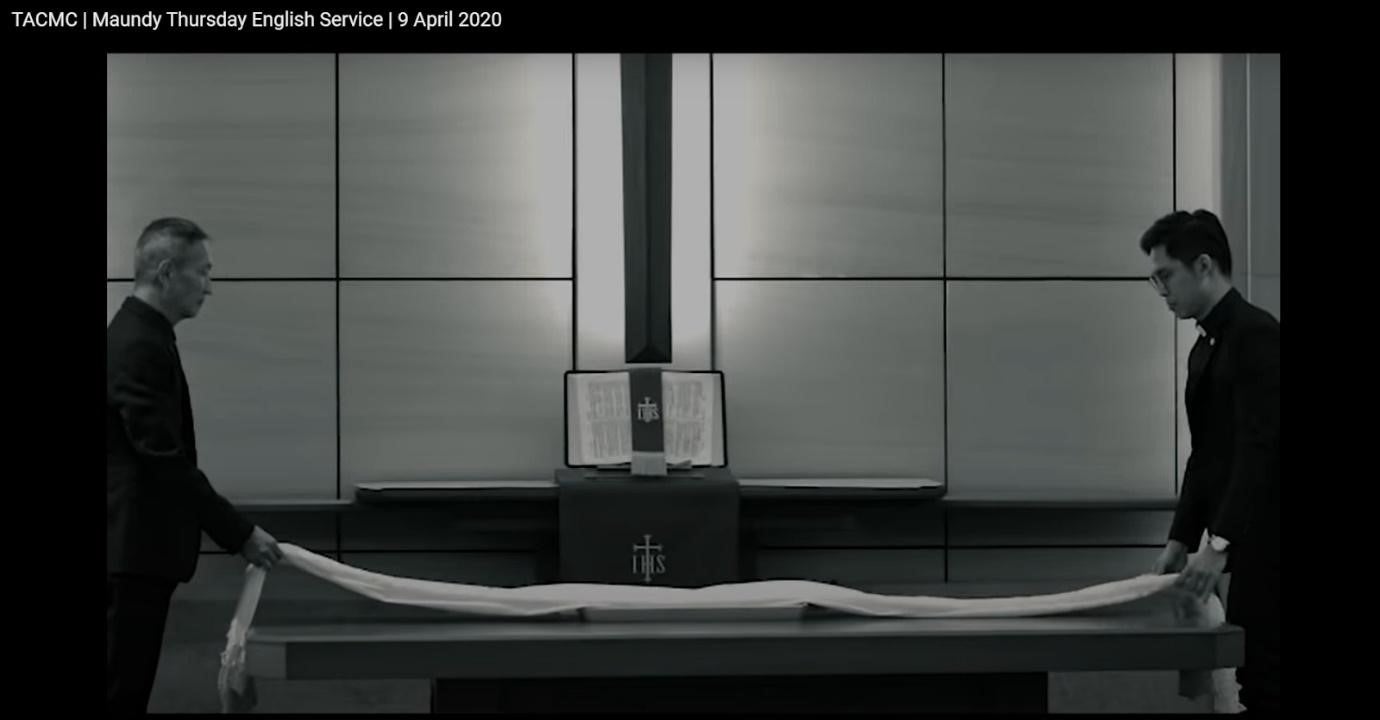
Screenshot from TACMC’s Youtube video which shows the ritual of removing sacred items from the table on Maundy Thursday, 9 April 2020 (https://www.youtube.com/watch?v=uOOGNHHIyVQ&t=6s)
Make Digitisation Inclusive
With Covid-19 set to stay for a while, many have started looking towards digitisation as a solution. Although the trend of moving rituals into the digital sphere may be inevitable, how can we ensure that it is inclusive and humanistic? The approach taken by these two historic places of worship provides food for thought.
While TACMC embraces digital technology on various fronts (e.g., holding cell group gatherings on Zoom), it has tried to bridge the digital divide so that worshippers who are less technology-savvy do not get excluded. For instance, the church has made available the audio version of its Sunday services in Mandarin and Hokkien via its existing Tinkle hotline (63244007). This also allows worshippers (e.g., seniors staying in hospitals) without internet access to continue worship.
For the generations of families who have been visiting Siang Cho Keong, the belief of praying before the deity in person is strong. The temple has always taken a very consultative approach in understanding its devotees’ needs and seeking guidance from its religious advisor. When the temple reopens, it hopes to gather the views of visiting devotees with regards to rituals going digital.
Indeed, high touch (metaphorically) is ever more important in a digital, contact-less “new normal”.
Lynn Wong is an independent researcher and filmmaker on a race against time to document and revive disappearing foods, festivals, and heritage in Singapore. She is also the co-investigator of Singapore Heritage Society’s two-year research project on 21 historic places of worship in Telok Ayer, Tanjong Pagar, and Tanjong Malang.
Disclaimer: The views and opinions expressed in this article are those of the authors and do not necessarily reflect the position of the blog editorial team or the Asia Research Institute.
South Asia | Southeast Asia | East Asia | Other Places | Hinduism | Buddhism | Islam | Christianity | Other Religions


